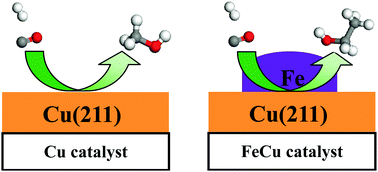当前位置:
X-MOL 学术
›
Phys. Chem. Chem. Phys.
›
论文详情
Our official English website, www.x-mol.net, welcomes your
feedback! (Note: you will need to create a separate account there.)
Formation of C2 oxygenates and ethanol from syngas on an Fe-decorated Cu-based catalyst: insight into the role of Fe as a promoter
Physical Chemistry Chemical Physics ( IF 2.9 ) Pub Date : 2017-11-01 00:00:00 , DOI: 10.1039/c7cp05411d Lixia Ling 1, 2, 3, 4, 5 , Qiang Wang 1, 2, 3, 4, 5 , Riguang Zhang 5, 6, 7, 8 , Debao Li 1, 2, 3, 4, 5 , Baojun Wang 5, 6, 7, 8
Physical Chemistry Chemical Physics ( IF 2.9 ) Pub Date : 2017-11-01 00:00:00 , DOI: 10.1039/c7cp05411d Lixia Ling 1, 2, 3, 4, 5 , Qiang Wang 1, 2, 3, 4, 5 , Riguang Zhang 5, 6, 7, 8 , Debao Li 1, 2, 3, 4, 5 , Baojun Wang 5, 6, 7, 8
Affiliation

|
In this study, the formation mechanism of C2 oxygenates and ethanol from syngas on Fe-decorated Cu bimetallic catalyst was investigated using density functional theory (DFT) calculations together with microkinetic modeling. The results showed that CH2 was the most favored monomer among all the CHx (x = 1–3) species over the FeCu bimetallic catalyst, which was more favorable than CH3OH formation. Namely, the FeCu catalyst exhibited a good selectivity toward CH2 formation instead of CH3OH formation in syngas conversion. Starting from the CH2 monomer, CH2CO and CH3CO via CO insertion into CH2 and CH2CO hydrogenation were the major products instead of C2 hydrocarbons or methane, CH3CO was successively hydrogenated to ethanol via CH3CHO and CH3CH2O intermediates. Moreover, the microkinetic modeling showed that the FeCu bimetallic catalyst had a high selectivity toward ethanol rather than methanol and methane. Further, the addition of Fe into the Cu catalyst promoted CHx formation by accelerating C–O bond cleavage, suppressed methanol formation, and facilitated C2 oxygenate formation rather than methane formation, suggesting that the synergetic effect between Fe and Cu played an important role in the formation of C2 oxygenates and ethanol. In addition, it is believed that the insights derived from this study can provide clues for the catalyst design of oxygenate synthesis and other bimetallic catalytic systems.
中文翻译:

在含Fe的Cu基催化剂上由合成气形成C 2氧化物和乙醇:深入了解Fe作为促进剂的作用
在这项研究中,使用密度泛函理论(DFT)计算和微观动力学模型,研究了Fe修饰的Cu双金属催化剂上合成气中C 2氧化物和乙醇的形成机理。结果表明,与FeCu双金属催化剂相比,CH 2是所有CH x(x = 1-3)物种中最受青睐的单体,比CH 3 OH的形成更有利。即,FeCu催化剂在合成气转化中显示出对CH 2形成的良好选择性,而不是对CH 3 OH形成的选择性。从CH 2单体,CH 2 CO和CH 3 CO开始,通过将CO插入CH 2和CH 2 CO氢化是主要产物,而不是C 2烃或甲烷,CH 3 CO依次通过CH 3 CHO和CH 3 CH 2 O中间体氢化为乙醇。此外,微动力学模型表明FeCu双金属催化剂对乙醇而不是甲醇和甲烷具有高选择性。此外,将Fe添加到Cu催化剂中可通过加速C–O键的裂解促进CH x的形成,抑制甲醇的形成,并促进C 2的形成。含氧化合物而不是甲烷的形成,表明铁和铜之间的协同作用在C 2含氧化合物和乙醇的形成中起着重要作用。此外,据信从这项研究中得出的见解可以为含氧化合物合成和其他双金属催化体系的催化剂设计提供线索。
更新日期:2017-11-22
中文翻译:

在含Fe的Cu基催化剂上由合成气形成C 2氧化物和乙醇:深入了解Fe作为促进剂的作用
在这项研究中,使用密度泛函理论(DFT)计算和微观动力学模型,研究了Fe修饰的Cu双金属催化剂上合成气中C 2氧化物和乙醇的形成机理。结果表明,与FeCu双金属催化剂相比,CH 2是所有CH x(x = 1-3)物种中最受青睐的单体,比CH 3 OH的形成更有利。即,FeCu催化剂在合成气转化中显示出对CH 2形成的良好选择性,而不是对CH 3 OH形成的选择性。从CH 2单体,CH 2 CO和CH 3 CO开始,通过将CO插入CH 2和CH 2 CO氢化是主要产物,而不是C 2烃或甲烷,CH 3 CO依次通过CH 3 CHO和CH 3 CH 2 O中间体氢化为乙醇。此外,微动力学模型表明FeCu双金属催化剂对乙醇而不是甲醇和甲烷具有高选择性。此外,将Fe添加到Cu催化剂中可通过加速C–O键的裂解促进CH x的形成,抑制甲醇的形成,并促进C 2的形成。含氧化合物而不是甲烷的形成,表明铁和铜之间的协同作用在C 2含氧化合物和乙醇的形成中起着重要作用。此外,据信从这项研究中得出的见解可以为含氧化合物合成和其他双金属催化体系的催化剂设计提供线索。











































 京公网安备 11010802027423号
京公网安备 11010802027423号